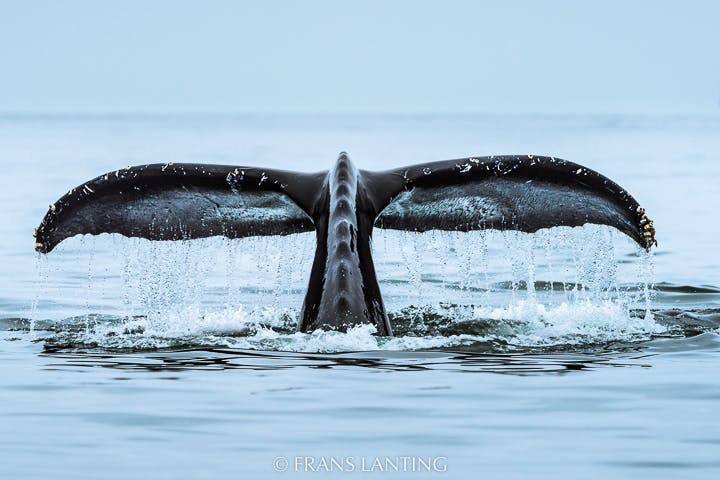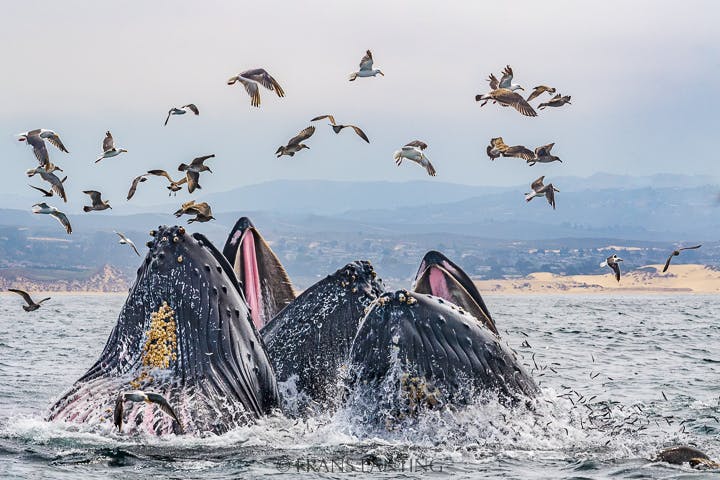I am amazed during each visit how the stark pavement and clean lines of modern architecture that houses Lanting Studios off Swift Street never prepare a visitor for the wonder that awaits inside the front door. The eye is immediately drawn to a predator in the corner as a mountain lion stares intently from the bush. The studio is where a majestic whale breach photograph pairs nicely with migrating birds under the watchful eye of a giant elephant.
Bay of Life
Frans Lanting & Chris Eckstrom’s intimate vision of Monterey Bay




One’s life work is rarely displayed so conveniently for others to observe at leisure.
Cameras, tripods, housings, and equipment fill the reception area. I have arrived for a discussion with Frans Lanting and Chis Eckstrom about their book, Bay Of Life, but realize quickly that the couple is preparing for another adventure.
“Antarctica,” Lanting explains. I look again at all the necessary preparations for a trip to the world’s southernmost continent. “It will be my 19th time and Chris’s 14th trip. The whole team takes a lot of work to get ready.”
For some reason, it seems appropriate to start a conversation about “Bay of Life,” the couple’s love letter to our local environment, with a touchstone reference to a location nearly 9,000 miles from home. Their global perspective and travels were fundamental in driving their deep passion for the Monterey Bay ecosystem.
The simplest way to define Monterey Bay and highlight its uniqueness is to recognize it as the hottest hotspot for biodiversity in North America – a bold claim – according to Lanting. Lanting credits his wife with the concept she developed to describe the bay’s distinctive nature.
Frans LantingWhen you look at the mountain ranges and the way they are orientated and the orientation of the rivers and then include this phenomenon of the marine canyon, it is all incredibly diverse. Nature thrives in diversity.

“Chis wrote in the introduction that if you took a zip line from the top of Loma Prieta down to the bottom of the marine canyon underwater with an imaginary submersible, you would encounter, along that ride, a diversity of habitats and life that is unparalleled on the planet.”
What sets the area apart is the unique way in which the land meets the sea. The marine canyon Lanting referred to, Monterey Canyon, reaches staggering depths greater than two miles. If one were to leave the canyon, they would be met with a rugged cliff line and sandy beaches that immediately give way to lush forests.
“The fact that it is so diverse here reflects how unusual the topography is.” Lanting points out one of the maps included in “Bay of Life” to accentuate his point. “When you look at the mountain ranges and the way they are orientated and the orientation of the rivers and then include this phenomenon of the marine canyon, it is all incredibly diverse. Nature thrives in diversity.”

“Bay of Life” is an ambitious effort.
“The book celebrates Monterey Bay as the world-class environment and pays tribute to the people caring for it.” These opening words presented in the forward written by Leon Panetta set the tone for the mission of the book and the connected mission with the Bay of Life Fund. Gifts to the fund support local nonprofit organizations active in conservation and education in the Monterey Bay, focusing on partnerships and participating organizations’ collaborative efforts.
Chris EckstromThere is so much here. I wondered how I could fly over it all, to have a bird’s eye perspective, like a condor flying over the top of it all…
“We were thinking about how we cover all these habitats; it is just so complex and diverse.” She eventually leaned on what she knew best for inspiration: nature. “There is so much here. I wondered how I could fly over it all, to have a bird’s eye perspective, like a condor flying over the top of it all. I also realized we would need to be closer than that for the reader, more visceral to guide them. We wanted to take the reader from the top of that mountain to the bottom of the bay.”
The book is intensely purposeful, but there is a more profound connection a reader feels between the legendary photography by Lanting and the supporting words from Eckstrom. It is hard not to see a direct comparison to the subject matter and the couple. Much like the biodiversity of Monterey Bay, which is shaped by its unique topography, it’s equally impossible to be in a room with Lanting and Eckstrom and not sense the rarity of their partnership. Noticing this sentiment in the room, I asked if it was a perspective they both shared.
“Chris and I co-created the project. We have a very unusual creative relationship. We are like an old couple,” Lanting laughs as Eckstrom nods. “We –”
“We channel each other,” Eckstrom cuts in and lightly touches his shoulder.
“Yes. We channel each other. We finish each other’s sentences,” Lanting says as he leafs through the “Bay of Life” book on the table, “For us creatively, it just goes back and forth in a way that has been very successful for us.”
Is the photographer the muse for the writer, or is the writer the inspiration for the photographer?
“At the core of it, we both like to give shape to ideas.” Lanting sees it as a perfect marriage in both the natural world and the real world creatively. “Those ideas for us get expressed through images and words.”
Fittingly, Eckstrom picks up the narrative as Lanting trails off, finishing the thought.
“We always want to find the strongest way to tell the story.”


BAY OF LIFE
BOOK PREVIEW
BY FRANS LANTING AND CHRIS ECKSTROM
We have been privileged to document our planet’s natural heritage on assignment for National Geographic for more than 30 years — from the icy edges of Antarctica to the Savannahs of Africa and the jungles of Borneo. But the place we know best and love most is California’s Monterey Bay. We have lived here for many years and come home from our travels to a secluded Coastal Meadow north of Santa Cruz. To us, Monterey Bay is one of Earth’s natural crown jewels.
The richness of the Bay’s Marine Wildlife reminds us of islands near Antarctica, like South Georgia, whose shores are packed with seals and seabirds, much like the beaches of Año Nuevo. Cold water supports abundant life here as it does in the subantarctic. The Botanical richness of the Monterey Bay Region reminds us of parts of South Africa, which is the epicenter of floral diversity, just like the Central Coast of California.
According to a study by The Nature Conservancy, Monterey Bay is the hottest hotspot for biodiversity in all of North America. But that assessment did not include its marine life, which is astonishing in its own right. Land and sea are often looked at separately by researchers and planners. In “Bay of Life,” we bring the two together for a unified view of the bay and its natural abundance due to a unique mix of physical features and microclimates shaped by the powerful influence of the ocean. We know of no other place in the world where land and sea connect extraordinarily.
This is a place of giants, from Redwood forests standing tall on land to forests of kelp swing in the current offshore. It supports iconic wildlife from secretive mountain lions to majestic blue whales in a region where far-flung migrants mixed with local endemics. Monterey Bay is both a crossroads and an epicenter for many life forms. It is the southern boundary for species like coast redwoods and coho salmon and is the northern boundary for roadrunners in Monterey Pines. It is an epicenter for sea otters rafting by the dozens in sheltered waters for spectacular summertime congregations of sooty shearwaters. It is the only place you can find the Santa Cruz Cypress in the Ohlone tiger beetle, two of many species living nowhere else.
Monterey Bay’s natural abundance results from a unique confluence of land and sea, shaped by the forces of fog and fire and influenced by people’s actions. After the Gold Rush, massive overexploitation of resources stripped the land of trees and the seas of fish and marine mammals. But that ecological collapse has been reversed in our time. In the upcoming issues of Santa Cruz Vibes magazine, we will use excerpts from “Bay of Life” to describe a remarkable recovery that shows that damaged ecosystems can be restored when people care for and act together and offer a model for other places when we need such stories of hope.
We hope this series will motivate readers to join us and contribute to a future worthy of this magnificent Bay of Life we all share.
Editor’s Note
In the creative tandem of Lanting and Eckstrom, “Bay of Life” captures the very soul of Monterey Bay. It’s more than a subject. It’s a shared responsibility and commitment to safeguarding the delicate balance that sustains us all. Stay tuned as Santa Cruz VIBES provides more insights into our extraordinary Monterey Bay. Meanwhile, grab a copy of the book and consider supporting the Bay of Life Fund.

